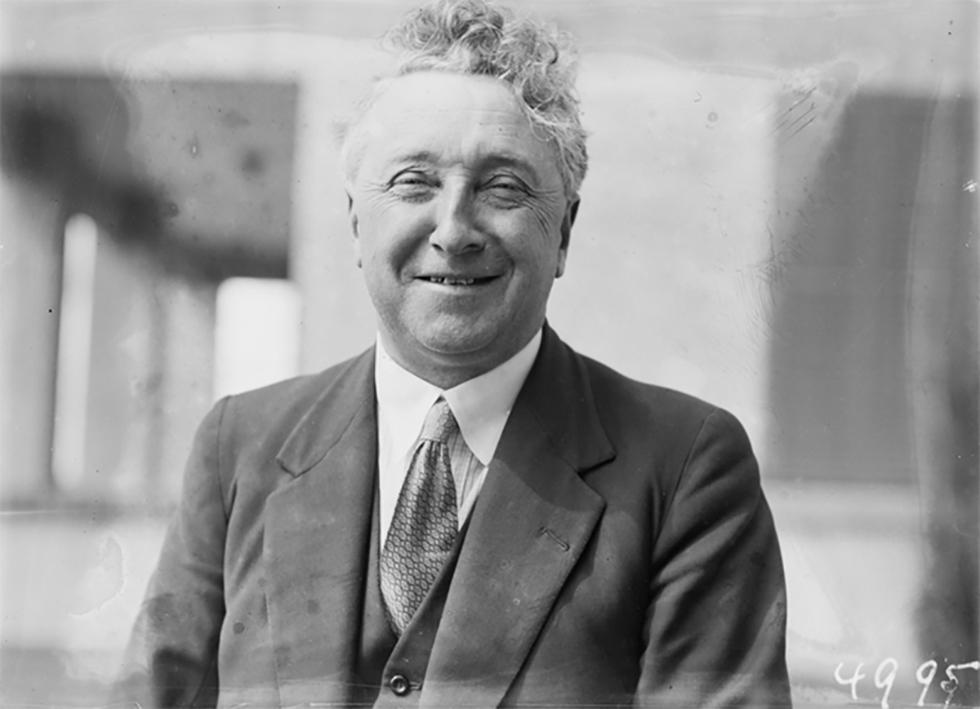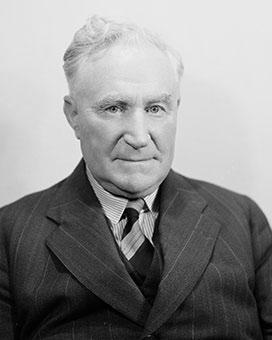Joseph Aloysius (Joe) Lyons was elected to the federal House of Representatives as Member for Wilmot in 1929. Before that, he had been a Tasmanian Labor parliamentarian for 20 years, representing the Division of Wilmot, and was State Premier from 1923 to 1928. Lyons was in Federal Parliament for only 2 years when he became the Prime Minister.
Lyons was a minister in the Labor government of James Scullin. He resigned from the Cabinet and the Labor Party in 1931 and formed the United Australia Party, triggering the defeat of the Scullin government at the December 1931 federal election.

Joseph Lyons NAA: A3560, 4995
Early years
Lyons was born at Stanley in north-western Tasmania on 15 September 1879. He was one of 8 children of Irish immigrants, Ellen and Michael Lyons. In 1887, the family were plunged into poverty after an unfortunate Melbourne Cup bet and, at age 9, Lyons was working at odd jobs, as well as attending the convent school at Ulverstone. In 1891, when he was 12 years old, his mother’s sisters paid his upkeep so he could go to the state school at Stanley. At 16, he became a pupil-teacher, completing his training in 1901.
His first teaching posts were tiny country schools in north-western Tasmania. In 1905, he transferred to Smithton as head teacher. There Lyons started the Duck River branch of the Workers Political League and a local debating society. In 1907, when he was 26, Lyons formally qualified at Tasmania’s new teacher training college in Hobart.
State Labor politician
In 1909, Lyons won the seat of Wilmot in the Tasmanian parliament. Among the many people he knew through the Workers Political League, the debating societies and Labor discussion groups, was Eliza Burnell. In June 1913, when visiting her 15-year-old daughter Enid who was a trainee teacher at the Hobart college, Eliza Burnell introduced Enid to Lyons at Parliament House. The wedding of Lyons and Enid Burnell on 28 April 1915 was the start of one of the best-known marriage in Australian politics.
From April 1914 until April 1916, Lyons was the State Treasurer, Minister for Railways, and Minister for Education in the Tasmanian Labor government of John Earle. During this time, he improved pay and conditions for teachers, abolished state school fees, and established Tasmania’s first 2 high schools, in Hobart and Launceston. The Labor Party was defeated in the election of April 1916.
Like others in the Labor Party whose background was Irish, Lyons supported Home Rule. In 1916, he was the vice-president of the Hobart United Irish League. He was also an opponent of conscription. When the Labor party split over conscription, Lyons replaced John Earle as leader on 2 November 1916 and became Leader of the Opposition, a position he held for nearly 7 years. In December 1919, he stood unsuccessfully for the federal House of Representatives seat of Darwin, the west coast electorate held by King O’Malley until 1917, when O’Malley lost to a pro-conscription Nationalist candidate.
In October 1923, after disintegration of the Nationalist Government led by Sir Walter Lee, Lyons became Premier of Tasmania. Leading a minority Labor government, he had the support of some Nationalist members. Lyons sought advice from business people and from economists like Lyndhurst Giblin. His working relationships with Tasmanian Nationalists extended to members of the Bruce–Page federal government, and to Treasury officials in Melbourne. Although Lyons introduced financial reforms and achieved some improvement in developing an industrial base for the state, Labor lost government in 1928.
Depression politics
Lyons’ consensual politics as Premier had lost him trade unionist support in his party. However, with the encouragement of federal Opposition Leader James Scullin, Lyons stood for the House of Representatives in October 1929. He was returned in Labor’s landslide win, and represented Wilmot in the House for the next 10 years.
Lyons joined Scullin’s Cabinet as Postmaster-General and Minister for Works and Railways. When Treasurer Ted Theodore was required to stand down from Cabinet in August 1930, Lyons became acting Treasurer. Lyons and acting Prime Minister James Fenton negotiated the difficult path of implementing strategies for combatting the Depression, while Scullin was in London from August 1930 to January 1931. They kept in constant contact with a stream of cables.
Lyons and Fenton were frequently in conflict with both Cabinet and Caucus as they grappled with the intricacies of reconciling the competing approaches of their party, the premiers, Commonwealth Bank head Robert Gibson and British adviser Otto Niemeyer. Among the partisans in this volatile mix was the fiery Premier of New South Wales, Jack Lang, whose approach (shared by Scullin’s Health Minister Frank Anstey) was to default on the state and federal loan repayments due to London bankers.
Lyons had been an orthodox fiscal manager as premier, and remained so as acting Treasurer. Lyons sought the advice of Lyndhurst Giblin, Robert Gibson and Alfred Davidson, rather than the more challenging strategies of Ted Theodore. The collision course with Cabinet was stormy but short. When Scullin secured the reinstatement of Theodore as Treasurer in January 1931, Lyons and Fenton immediately resigned from Cabinet.
Leader of a new party – the United Australia Party
Resigning from Scullin’s ministry was far from a leap into the wilderness. Through their obstinacy in confronting Caucus over the issue of responsible economic management, Lyons and Fenton had attracted a prominent set of conservative supporters. Known as ‘the Group’, these conservatives included Robert Menzies and a former Tasmanian acquaintance of Lyons, financier Staniforth Ricketson.
In parliament on 13 March 1931, Lyons spoke in support of a motion of no confidence in the Labor government of which he was still a member. With the powerful support of Keith Murdoch, the United Australia Party was created from a coalition comprising citizens’ groups and Nationalist Party support negotiated by members of ‘the Group’. Lyons left the Labor Party to become parliamentary leader of the new United Australia Party. John Latham, Nationalist Leader of the Opposition, stood aside and became deputy leader.
When the Lang Labor dissidents moved against Scullin late in the parliamentary session, Lyons joined them in securing the fall of the government. The victory of the United Australia Party at the subsequent election meant that in less than 1 year, Lyons had transformed himself from dissident and defector to prime minister.
Sources
- Hughes, CA, Mr Prime Minister: Australian Prime Ministers 1901–72, Oxford University Press, Melbourne, 1976.
- Lyons, Enid, So We Take Comfort, William Heinemann, Melbourne, 1965.
- Souter, Gavin, Acts of Parliament, Melbourne University Press, Melbourne, 1988.
- White, Kate, Joseph Lyons, Prime Minister of Australia 1932–1939, Black Inc., Melbourne, 2000.





